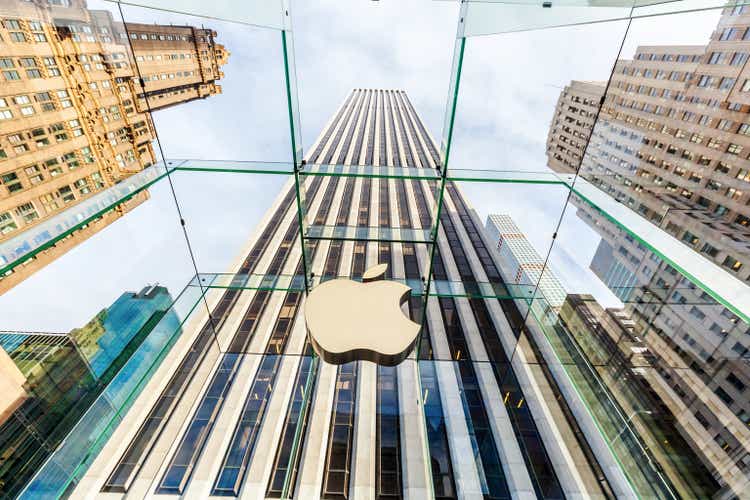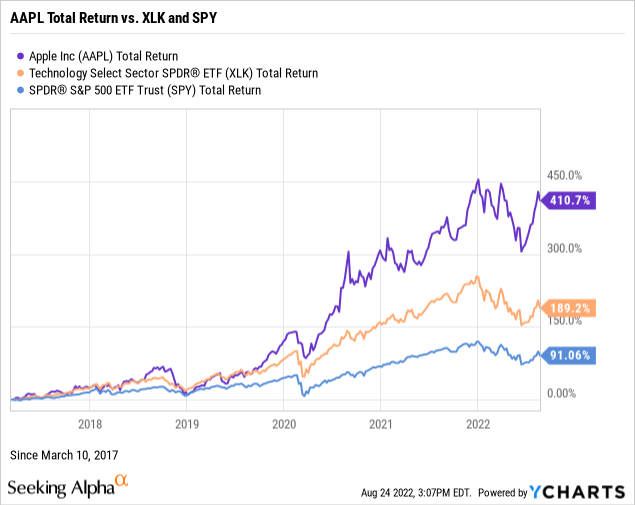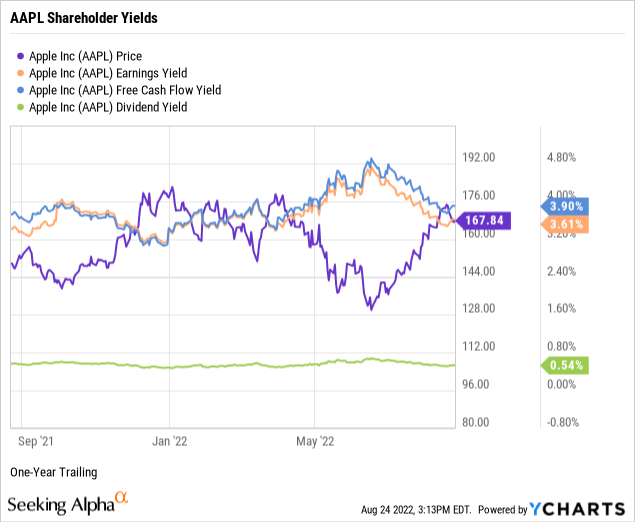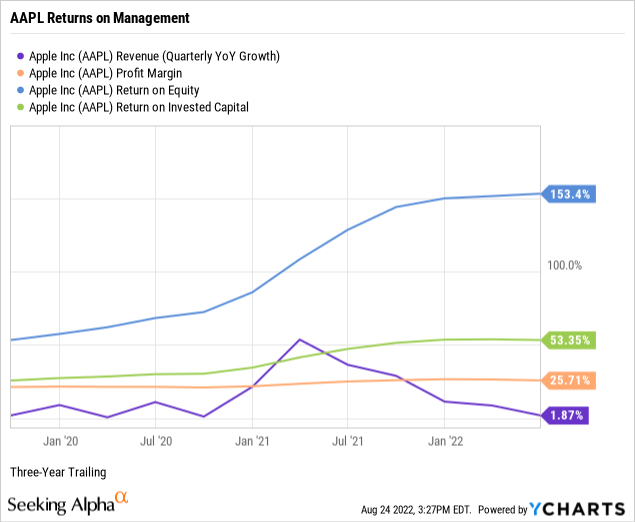chris-mueller
As widely reported per its 13F filings, Warren Buffett’s Berkshire Hathaway (NYSE:BRK.B) has a stake in Apple Inc. (NASDAQ:AAPL), representing over 40% of his conglomerate’s public equity holdings.
After foolishly selling out my shares of AAPL following the death of founder Steve Jobs, I initiated a new position in our family portfolio in March 2017. What’s good for Mr. Buffett is good for us. However, unlike the Oracle of Omaha, I follow an equal weighting portfolio strategy to avoid trying to predict which stocks will outperform in the long run.
In this updated primary ticker research report, I put Apple and its common shares through my market-beating, data-driven investment research checklist of the value proposition, shareholder yields, fundamentals, valuation, and downside risk.
The resulting investment thesis:
Under Steve Jobs’ innovations, Tim Cook’s leadership, and Warren Buffett’s confident ownership stake, Apple is a buy and hold forever enduring masterful enterprise. The stock price, however, appears to be currently trading at a premium.
My overall rating: Hold, based on a bullish view of the company and a neutral view of the stock.
A more in-depth version of this report, including metric targets, was first shared with subscribers to my Quality + Value Strategies service on the Seeking Alpha Marketplace on August 22.
Unless noted, all data presented is sourced from Seeking Alpha and YCharts as of the intraday market on August 24, 2022; and intended for illustration only.
The Reigning King of Hardware and Services
AAPL is a dividend-paying large-cap stock in the information technology sector’s hardware, storage and peripherals industry.
Apple, Inc. designs, manufactures, and markets smartphones, personal computers, tablets, wearables, and accessories worldwide. It also sells various related services. Apple was incorporated in 1977 and is headquartered in Cupertino, California, USA.
My value proposition elevator pitch for Apple:
The reigning king of productivity hardware and services whether business or personal, mobile, wearables, television, or desktop.
The chart below illustrates the stock’s performance against the Technology Select Sector SPDR Fund ETF (NYSE:XLK) and the SPDR S&P 500 ETF Trust (NYSE:SPY) since adding the shares to our family portfolio on March 10, 2017.
Ultimately, investing in individual common stocks should aim to beat the benchmark indices over time. For example, AAPL has more than doubled the returns of its sector and was a four-bagger against the market during the past five-plus years.
My value proposition rating for AAPL: Bullish.

Shareholder Yields on Cost Beat the 10-Year
As part of my due diligence, I average the total shareholder yields on earnings, free cash flow, and dividends to measure how a targeted stock compares to the prevailing yield on the 10-year Treasury benchmark note. In other words, what is the equity bond rate of the common shares?
As demonstrated in the below chart, AAPL’s earnings yield was trading at 3.61%, and its free cash flow yield was 3.90%.
Apple offers a modest dividend yield of 0.54%. However, its super conservative 14.69% payout ratio indicates a safe, well-covered dividend with plenty of room for annual raises. Further, AAPL was yielding 2.81% on our family portfolio’s split- and dividend-adjusted cost basis of $32.72 per share, or 227 basis points above the forward yield. Yet another reminder that buy and hold quality value investing works.
Next, let’s take the average of the three shareholder yields to measure how the stock compares to the prevailing yield of 3.11% on the 10-Year Treasury benchmark note. For example, the average shareholder yield for AAPL was 2.68%. However, the average yield was 3.44%, using the stock’s dividend yield on our cost basis. Arguably, equities are deemed riskier than U.S. bonds. Thus, securities such as AAPL that reward long-term shareholders with yields higher than the government benchmark favor owning the stock instead of the bond.
Remember that earnings and free cash flow yields are inverse valuation multiples, suggesting that AAPL trades at a premium. I’ll further explore valuation later in this report.
My shareholder yields rating for AAPL: Neutral, based on the forward dividend yield.

ROE and ROIC Embarrass the Tech Sector
Let’s explore the fundamentals of Apple, uncovering the performance strength of the company’s senior management.
Per the below chart, Apple had three-year revenue growth of 1.87%, underperforming the 6.16% median growth for the information technology sector. On the contrary, the company had a superior trailing three-year pre-tax net profit margin of 25.71%, far outperforming the sector’s median net margin of 4.25%.
Apple was producing a trailing three-year return on equity tor ROE at an astounding 153.40% against a median ROE of just 7.28% for the sector. Arguably, the escalating equity returns reflect the board’s stock repurchases, a good sign for shareholders.
At 53.35%, Apple’s return on invested capital or ROIC also embarrasses the sector’s median ROIC of just 3.98%, indicating that Apple’s senior executives are spectacular capital allocators.
ROIC needs to exceed the weighted average cost of capital or WACC by a comfortable margin, giving management’s ability to outperform its capital costs. For example, Apple’s ROIC far exceeds its trailing WACC of 10.48% (Source: GuruFocus).
The consistent, although slowing revenue growth, phenomenal net profit margin, and super high returns on equity and capital indicate world-class management performance in Cupertino.
My fundamentals rating for AAPL: Bullish.

Premium-Priced Stock of a Legacy Enterprise
I rely on just four valuation multiples to estimate the intrinsic value of a targeted quality enterprise’s stock price.
At 7.13 times, AAPL’s price-to-sales ratio or P/S exceeded 2.91 times sales for the information technology sector and 2.52 P/S for the S&P 500. Thus, the weighted industry plus market sentiment suggests an overvalued stock price relative to Apple’s topline.
AAPL had a price-to-earnings multiple or P/E of 27.72 times against a sector P/E of 24.53, indicating investor sentiment fairly prices the stock relative to earnings per share. Further, AAPL was trading at a higher multiple than the S&P 500’s recent overall P/E of 23.18. (Source of S&P 500 P/E: Barron’s).
At 23.38 times, AAPL was trading at a price-to-operating cash flow multiple in the neighborhood of the sector’s median of 20.07, indicating the market prices the stock at a fair value relative to current cash flows.
Against the broader sector median of 19.75 times, AAPL was trading at 22.90 times enterprise value to operating earnings or EV/EBIT, signaling the stock was overbought or undersold by the market.
Weighting the preferred valuation multiples suggests the market fairly values Apple’s stock price to sales, earnings, cash flow, and enterprise value. Therefore, based on the fundamentals and valuation metrics uncovered in this report, risks and potential catalysts notwithstanding, I would call AAPL a premium-priced stock of a legacy A-rated technology enterprise.
My valuation rating for AAPL: Neutral.

Narrow Moat-Rated But Wide Moat Results
When assessing the downside risks of a company and its common shares, I focus on five metrics that, in my experience as an individual investor and market observer, often predict the potential risk/reward of the investment. Hence, I assign a downside risk-weighted rating of above average, average, below average, or low, biased toward below average and low-risk profiles.
Alpha-rich investors target companies with clear competitive advantages from their products or services. An investor or analyst can streamline the value proposition of an enterprise with an economic moat assignment of wide, narrow, or none. The leading moat analyst, Morningstar, assigns Apple a narrow moat rating.
A favorite of the legendary value investor Benjamin Graham, long-term debt coverage demonstrates balance sheet liquidity or a company’s capacity to pay down debt in a crisis. For example, as reported on its June 2022 quarterly financial statements, Apple’s long-term debt coverage was 1.19 times.
In theory, the company could pay off 100% of its longer-term debt obligations in a crisis using its liquid assets such as cash and equivalents, short-term investments, accounts receivables, and inventory.
On the contrary, Apple’s short-term debt coverage or current ratio was 0.86 times. Thus, its balance sheet provides less than sufficient liquid assets to pay down 100% of its current liabilities, including accounts payable, accrued expenses, short-term borrowings, and income taxes.
AAPL’s 60-month trailing beta was 1.24. Its shorter-term 24-month beta was about equal at 1.21. With price volatility trading somewhat above the S&P 500 standard of 1.00, AAPL presents as a market perform-type core holding.
The short interest percentage of the float for AAPL was a bear paws-off of just 0.67%, signaling the near-sighted short traders view the stock as a safe technology staple supported by a loyal customer and investor base.
Apple is a fundamentally solid, narrow moat company with wide-moat results and an appealing risk profile.
My downside risk rating for AAPL: Below Average.
Long Apple Remains a Good Idea
Catalysts confirming or contradicting my overall hold investment thesis on Apple Inc. and its common shares include, but are not limited to:
- Confirmations: Between new sales in emerging markets and repeat sales to current customers, Apple has plenty of opportunities for the continued growth of its products and services. Plus, its superior iOS operating system bodes well for long-term customer retention. Thus, Apple remains an innovator with solid branding and customer loyalty generating legendary cash flows.
- Contradictions: Apple’s premium pricing strategy could limit sales growth in a prolonged recession. The company may need to catch up to Google (GOOG) (GOOGL) and Amazon (AMZN) in artificial intelligence to maintain premium customer service. As widely reported, its board is buying back more shares using bond sales to finance the repurchases, which also means more debt.
As the title of my previous Apple article suggested over five years ago, Apple remains a good idea for long-term investors. Whenever the price is right, buy and hold forever and ever. Amen.


Be the first to comment